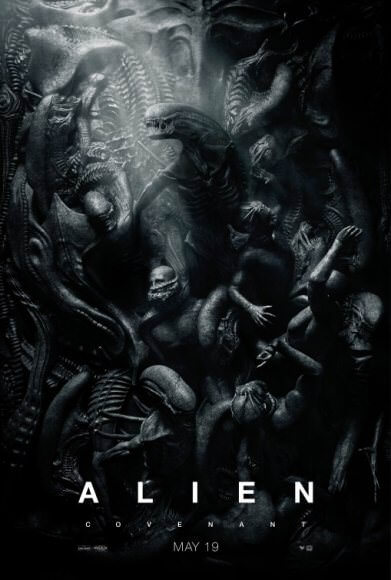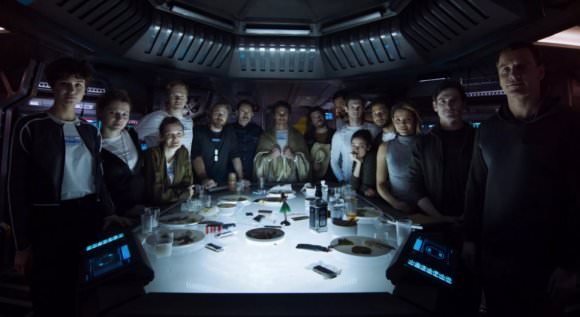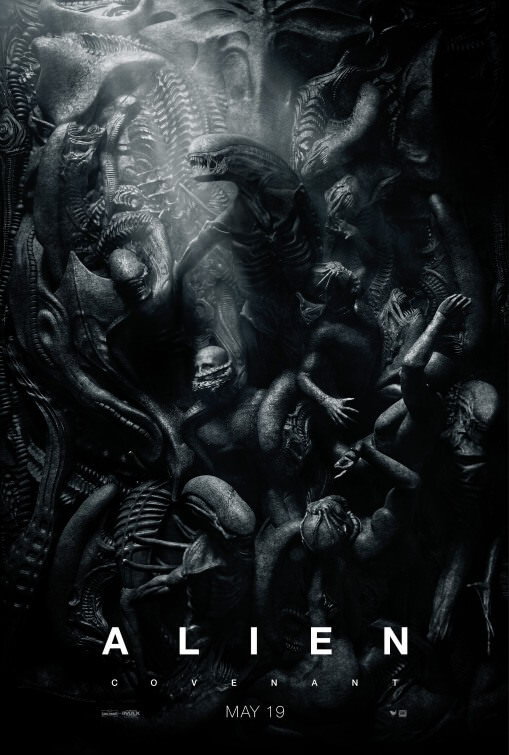
Warning: mild plot spoilers ahead for the upcoming summer film Alien: Covenant, though we plan to focus more on the overall Alien sci-fi franchise and some of the science depicted in the movie.
So, are you excited for the 2017 movie season? U.S. Memorial Day weekend is almost upon us, and that means big ticket, explosion-laden sci-fi flicks and reboots/sequels. Lots of sequels. We recently got a chance to check out Alien: Covenant opening Thursday, May 18th as the second prequel and the seventh film (if you count 2004’s Alien vs. Predator offshoot) in the Alien franchise.
We’ll say right up front that we were both excited and skeptical to see the film… excited, because the early Alien films still stand as some of the best horror sci-fi ever made. But we were skeptical, as 2012’s Prometheus was lackluster at best. Plus, Prometheus hits you with an astronomical doozy in the form of the “alien star chart” right off the bat, not a great first step. Probably the best scene is Noomi Rapace’s terrifying self-surgery to remove the alien parasite. Mark Watney had to do something similar to remove the antenna impaled in his side in The Martian. Apparently, Ridley Scott likes to use this sort of scene to really gross audiences out. The second Aliens film probably stands as the benchmark for the series, and the third film lost fans almost immediately with the death of Newt at the very beginning, the girl Sigourney Weaver and crew fought so hard to save in Aliens.
How well does Alien: Covenant hold up? Well, while it was a better attempt at a prequel than Prometheus, it approaches though doesn’t surpass the iconic first two. Alien: Covenant is very similar to Aliens, right down to the same action beats.
The story opens as the crew of the first Earth interstellar colony ship Covenant heads towards a promised paradise planet Origae-6. En route, the crew receives a distress signal from the world where the ill-fated Prometheus disappeared, and detours to investigate. If you’ve never seen an Alien film before, we can tell you that investigating a mysterious transmission is always a very bad idea, as blood and gore via face-hugging parasites is bound to ensue. As with every Alien film, the crew of the Covenant is an entirely new cast, with Katherine Waterston as the new chief protagonist similar to Sigourney Weaver in the original films. And like any sci-fi horror film, expect few survivors.
Alien: Covenant is a worthy addition to the Alien franchise for fans who know what to expect, hearkening back to the original films. As a summer blockbuster, it has a bit of an uphill battle, with a slower opening before the real drama begins.
So how does the science of Alien: Covenant hold up?
The Good: Well, as with the earlier films, we always liked how the aliens in the franchise were truly, well, alien, not just human actors with cosmetic flourishes such as antennae or pointed ears. Humans are the result of evolutionary fortuity, assuring that an alien life form will trend more towards the heptapods in Arrival than Star Trek’s Mr. Spock. Still more is revealed about the parasitic aliens in Alien: Covenant, though the whole idea of a inter-genetic human alien hybrid advanced in the later films seems like a tall order… what if their DNA helix curled the wrong way? Or was triple or single, instead of double stranded?
Spaceships spin for gravity in the Alien universe, and I always liked Scott’s industrial-looking, gray steel and rough edges world in the Alien films, very 2001: A Space Odyssey.
Now, for a very few pedantic nit picks. You knew they were coming, right? In the opening scenes, the Covenant gets hit with a “neutrino burst” dramatically disabling the deployed solar array and killing a portion of the hibernating crew. Through neutrinos are real, they, for the most part, pass right through solid matter, with nary a hit. Millions are passing through you and me, right now. The burst is later described as due to a “stellar ignition event” (a flare? Maybe a nova?) Though the crew states there’s no way to predict these beforehand… but even today there is, as missions such as the Solar Dynamics Observatory and SOHO monitor Sol around the clock. And we do know which nearby stars such as Betelgeuse and Spica are likely to go supernova, and that red dwarfs are tempestuous flare stars. An interstellar colonization mission would (or at least should) know to monitor nearby stars (if any) for activity. True, a similar sort of maguffin in the form of the overblown Mars sandstorm was used in The Martian to get things rolling plot-wise, but we think maybe something like equally unpredictable bursts high-energy cosmic rays would be a bigger threat to an interstellar mission.
The crew also decides to detour while moving at presumably relativistic speeds to investigate the strange signal. This actually happens lots in sci-fi, as it seems as easy as running errands around town to simply hop from one world to the next. In reality, mass and change of momentum are costly affairs in terms of energy. In space, you want to get there quickly, but any interstellar mission would involve long stretches of slow acceleration followed by deceleration to enter orbit at your destination… changing this flight plan would be out of the question, even for the futuristic crew of the Covenant.

Another tiny quibble: the Covenant’s computer pinpoints the source of the mysterious signal, and gives its coordinates in right ascension and declination. OK, this is good: RA and declination are part of a real coordinate system astronomers use to find things in the sky… here on Earth. It’s an equatorial system, though, hardly handy when you get out into space. Maybe a reference system using the plane of the Milky Way galaxy would be more useful.
But of course, had the crew of the Covenant uneventfully made it to Origae-6 and lived happily ever after stomach-exploding parasite free, there would be no film. Alien: Covenant is a worthy addition to the franchise and a better prequel attempt than Prometheus… though it doesn’t quite live up to the thrill ride of the first two, a tough act to follow in the realm of horror sci-fi.


Wait, wait, wait.
the Covenant gets hit with a “neutrino burst”
This makes “made the Kessel run in less than 12 parsecs” look like grad-level astrophysics (ignoring all the after-the-fact explanations for that statement).
Sigh.
Great review! Nice job of giving the context of the movie without overly divulging specifics.
I really like when Universe Today takes forays into science fiction, since science fiction has been such an integral part of the scientific process of inspiring scientists with actual ideas and goals towards which to strive.
Keep these coming…